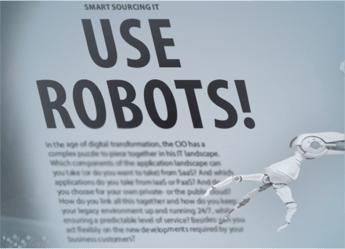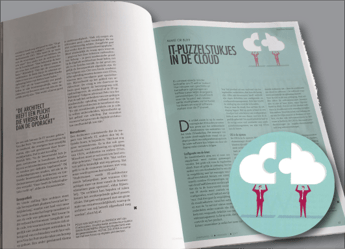IT puzzle pieces in the cloud
There is a decreasing need to ‘make’ IT. Buying seems to be more attractive – where possible and where you can find a suitable (and affordable) semi-finished product. The cloud is an interesting marketplace for this, supplying virtual hardware and primarily lots of software pieces for your IT puzzle.
This article focusses on the way a CIO could work with the well-thought-of cloud sourcing of pieces in the total IT Landscape. Managing the total cloud supply chain requires an appropriate product- and configuration management. The right software could help to control this challenge.
Configuration of the supply chain
Our colleagues in the manufacturing industry led the way here: a supply chain has to be managed continually – and so does the bought cloud. There lies the challenge. Ordering a cloud component is a piece of cake compared to managing a cloud factory within an enterprise, where there is a continual supply of IT applications based on semi-finished products from the cloud. Just as in the lean world, the use of IT requires ever more control over all the configurations, both initially and during the run.
Likewise, we can draw a comparison with the manufacturing industry. From the design stage right up to the in-service status, all the components must be under control. This entails a far-reaching definition of configuration management. Once that is in order, there is control of the product.
However, if you assemble the product from many bought components, this can be difficult. Each sub-supplier probably has their own definition of configuration and configuration management. In the same way, the challenge lies in maintaining control.
CIO in the squeeze
The CIO is in the squeeze. He fullfils the role of supply chain manager, as well as the role of product manager. His customers are seldom clear-cut and their needs vary widely. Some want IaaS and some want PaaS or SaaS. And yet others want mainly solutions.
However, they are all very interested in the cloud factory, where they can find everything they need. It is hard to convince them that the challenge of that cloud factory is configuration management, according to the definition of the manufacturing industry. Only when they are convinced can we give guarantees on matters like availability, security, scalability and costs.
Software at the heart of things
Whether you call it integration, assembly or configuration, using software is key. Software is the tooling that allows everything to communicate with everything else. It is semantics in an almost physical form.
Software ensures that software communicates with other software, and that hardware communicates with other hardware. Software glues the semi-finished products of the cloud together. However, the question is whether we are sufficiently aware of this fact. The cloud goes hand in hand with software and thus with software engineers, who ultimately create the digital solution.
This is a challenge for the CIO, as the software developers are not usually in his own team, but in R&D, for example. But the fact is that bad software can add unnecessary complexity to your cloud structure. It is therefore important to think and work in a DevOps way, and thus to include software developers in the team. So besides being a product manager and supply chain manager, the CIO is also a software manager.
Cloud control
It is necessary to gain insight into the use of cloud components with regard to functionality, costs, capacity, availability and security. Here, too, you can get software to help. There are many initiatives by various suppliers, who offer nice user-friendly user interfaces or simple APIs for managing the cloud supply chain properly.
The cloud is not about to happen – it has been here for a long time already. We still focus too little on this cloud factory, and we need to follow in the steps of the manufacturing industry. We need to search for definitions and forms of implementation for product management, configuration management and eventually software management.
The emergence of the cloud offers many buying opportunities for creating better IT faster. But before we reach that point, we need to focus on installing the IT factory, while learning from the concepts of the manufacturing industry.






